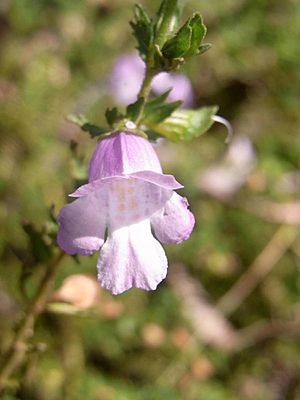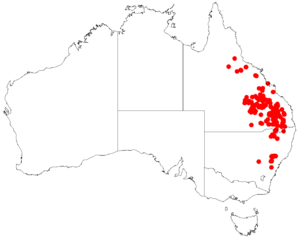Prostanthera cryptandroides facts for kids
Quick facts for kids Prostanthera cryptandroides |
|
|---|---|
 |
|
| In Burrendong Botanic Garden | |
| Conservation status | |
| Scientific classification | |
| Genus: |
Prostanthera
|
| Species: |
cryptandroides
|
 |
|
| Occurrence data from AVH | |
| Synonyms | |
|
Prostanthera odoratissima Benth. |
|
Prostanthera cryptandroides is a type of flowering plant. It belongs to the Lamiaceae family, which also includes mint. This plant is special because it only grows in eastern Australia. It's a small, spreading bush with thin, egg-shaped leaves. Its pretty flowers are usually lilac or mauve. They grow one by one where the leaves meet the stem.
Contents
What Does It Look Like?
Prostanthera cryptandroides is a low, spreading shrub. It has a strong, pleasant smell, like mint! Its branches have soft hairs and tiny sticky hairs called glandular hairs.
The leaves are light green and shaped like a narrow egg. They are about 6 to 9 millimeters long and 2 to 3 millimeters wide. The leaves either attach directly to the stem (this is called sessile) or have a very short stalk, less than 1 millimeter long. This stalk is called a petiole.
The flowers look like tubes. They grow in the upper parts of the plant, near the ends of the branches. At the base of each flower, there are small leaf-like parts called bracteoles. These are about 4 to 5 millimeters long but fall off as the flower grows.
The outer parts of the flower, called sepals, are 6 to 7 millimeters long. They form a tube about 3 to 4 millimeters long. This tube has two parts at the top, with the upper part being 3 to 4 millimeters long. The petals are a lovely lilac or mauve color. They are about 11 to 15 millimeters long. You can see this plant flowering from September to April.
How Was This Plant Named?
The plant Prostanthera cryptandroides was first officially described in 1834. A botanist named George Bentham wrote about it. He used notes from another botanist, Allan Cunningham, who had found the plant. Cunningham collected samples near the Hunter River. Bentham then published the description in his book, Labiatarum Genera et Species.
Later, in 1999, a botanist named Barry Conn looked closer at this plant. He found that there are two slightly different types, called subspecies. These subspecies are now officially recognized in Australia.
- The first type is Prostanthera cryptandroides subsp. cryptandroides. It's often called the Wollemi mint-bush. Its branches and sepals do not have the sticky stalked glandular hairs.
- The second type is Prostanthera cryptandroides subsp. euphrasioides. This one has those sticky stalked glandular hairs on its branches and sepals.
Where Does This Mint Bush Grow?
This mint bush likes to grow in forests. You can often find it in rocky areas. It grows all the way from the Leichhardt area in north Queensland down to northern New South Wales.
The Wollemi mint-bush (subsp. cryptandroides) has a smaller home range. It's found between the towns of Lithgow and Sandy Hollow in New South Wales. You can find populations of this subspecies inside the Wollemi and Gardens of Stone National Parks.
Is This Plant Protected?
The subspecies eudesmioides is not currently a big concern in Queensland. However, the Wollemi mint-bush (subspecies cryptandroides) is listed as "vulnerable". This means it needs protection. It's protected under Australian and New South Wales government laws.
The main reasons this subspecies is in danger are:
- Its natural home is being lost.
- Animals walking on it or eating it (trampling and grazing).
- Fires happening at the wrong times.
- Other plants (weeds) invading its space.
See also
 In Spanish: Prostanthera cryptandroides para niños
In Spanish: Prostanthera cryptandroides para niños


